(完整)初中英语主谓一致和就近原则讲解及练习.doc
- 格式:doc
- 大小:41.52 KB
- 文档页数:4
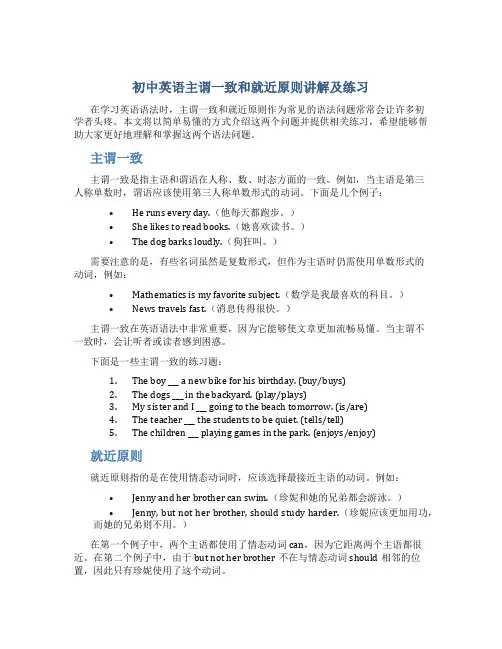
初中英语主谓一致和就近原则讲解及练习在学习英语语法时,主谓一致和就近原则作为常见的语法问题常常会让许多初学者头疼。
本文将以简单易懂的方式介绍这两个问题并提供相关练习,希望能够帮助大家更好地理解和掌握这两个语法问题。
主谓一致主谓一致是指主语和谓语在人称、数、时态方面的一致。
例如,当主语是第三人称单数时,谓语应该使用第三人称单数形式的动词。
下面是几个例子:•He runs every day.(他每天都跑步。
)•She likes to read books.(她喜欢读书。
)•The dog barks loudly.(狗狂叫。
)需要注意的是,有些名词虽然是复数形式,但作为主语时仍需使用单数形式的动词,例如:•Mathematics is my favorite subject.(数学是我最喜欢的科目。
)•News travels fast.(消息传得很快。
)主谓一致在英语语法中非常重要,因为它能够使文章更加流畅易懂。
当主谓不一致时,会让听者或读者感到困惑。
下面是一些主谓一致的练习题:1.The boy ___ a new bike for his birthday. (buy/buys)2.The dogs ___ in the backyard. (play/plays)3.My sister and I ___ going to the beach tomorrow. (is/are)4.The teacher ___ the students to be quiet. (tells/tell)5.The children ___ playing games in the park. (enjoys/enjoy)就近原则就近原则指的是在使用情态动词时,应该选择最接近主语的动词。
例如:•Jenny and her brother can swim.(珍妮和她的兄弟都会游泳。
)•Jenny, but not her brother, should study harder.(珍妮应该更加用功,而她的兄弟则不用。
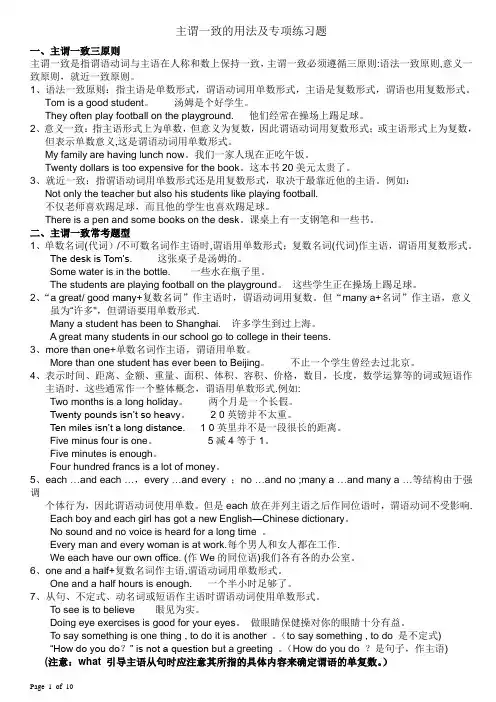
主谓一致的用法及专项练习题一、主谓一致三原则主谓一致是指谓语动词与主语在人称和数上保持一致,主谓一致必须遵循三原则:语法一致原则,意义一致原则,就近一致原则。
1、语法一致原则:指主语是单数形式,谓语动词用单数形式,主语是复数形式,谓语也用复数形式。
Tom is a good student。
汤姆是个好学生。
They often play football on the playground. 他们经常在操场上踢足球。
2、意义一致:指主语形式上为单数,但意义为复数,因此谓语动词用复数形式;或主语形式上为复数,但表示单数意义,这是谓语动词用单数形式。
My family are having lunch now。
我们一家人现在正吃午饭。
Twenty dollars is too expensive for the book。
这本书20美元太贵了。
3、就近一致:指谓语动词用单数形式还是用复数形式,取决于最靠近他的主语。
例如:Not only the teacher but also his students like playing football.不仅老师喜欢踢足球,而且他的学生也喜欢踢足球。
There is a pen and some books on the desk。
课桌上有一支钢笔和一些书。
二、主谓一致常考题型1、单数名词(代词)/不可数名词作主语时,谓语用单数形式;复数名词(代词)作主语,谓语用复数形式。
The desk is Tom’s. 这张桌子是汤姆的。
Some water is in the bottle. 一些水在瓶子里。
The students are playing football on the playground。
这些学生正在操场上踢足球。
2、“a great/ good many+复数名词”作主语时,谓语动词用复数。
但“many a+名词”作主语,意义虽为“许多",但谓语要用单数形式.Many a student has been to Shanghai. 许多学生到过上海。
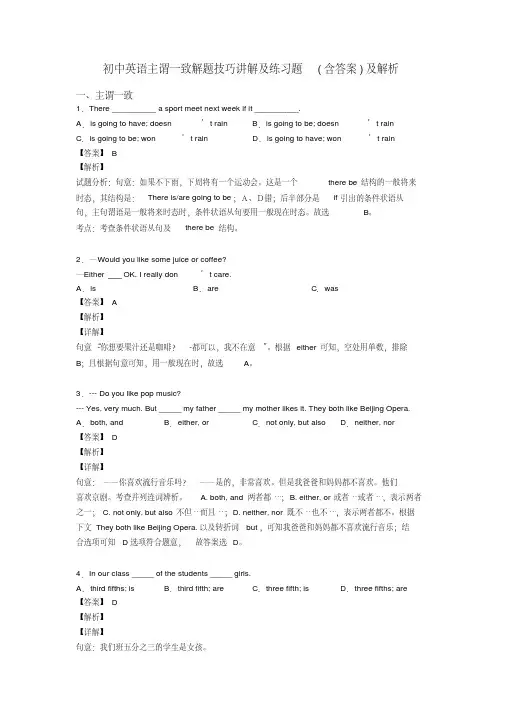
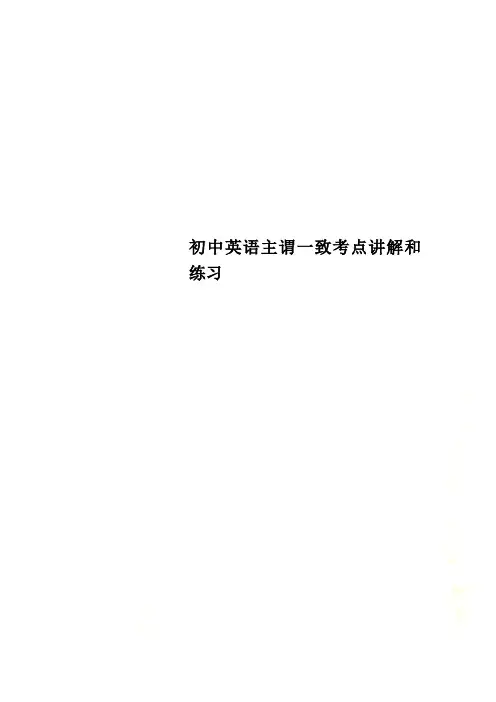
初中英语主谓一致考点讲解和练习主谓一致讲解和训练谓语受主语支配,须和主语在人称和数上保持一致,这叫做主谓一致。
主谓一致一般遵循三条原则:语法一致原则,意义一致原则和就近一致原则。
一、“三个一致”原则1. 语法一致的原则(1)以单数名词或代词,动词不定式短语作主语时,谓语动词要用单数;主语为复数时,谓语用复数,例如:He goes to school early every morning.The children are playing outside.To work hard is necessary for a student.(2)由and或both……and连接的并列成分作主语时,谓语动词用复数。
例如:Both he and I are right.Mr. Black and Mrs. Black have a son called Tom.但并列主语如果指的是同一人,同一事物或同一概念,谓语动词用单数。
例如:His teacher and friend is a beautiful girl.The poet and writer has come.(3)由and连接的并列单数主语之前如果分别由each, every修饰时,其谓语动词要用单数形式。
例如:In our country every boy and every girl has the right to receive education.Each man and each woman is asked to help.(4)主语是单数时,尽管后面跟有 but ,except, besides, with 等介词短语,谓语动词仍用单数。
例如:The teacher with his students is going to visit the museum.Nobody but two boys was late for class.Bread and butter is a daily food in the west.(5)一些只有复数形式的名词,如people, police, cattle, clothes 等作主语时,谓语动词要用复数。

主谓一致讲解及练习附答案Company number:【WTUT-WT88Y-W8BBGB-BWYTT-19998】主谓一致【考纲说明】1)掌握主谓一致三大原则:语法一致、意义一致和就近一致原则2)学会分析句式,排除干扰,分清主谓,明了句子的主谓关系3)本专题以单项选择、单词拼写和词形转换的考查为主,分值为1—2分。
【知识梳理】一、定义:谓语受主语支配,须和主语在人称和数上保持一致,这叫做主谓一致。
主谓一致一般遵循三条原则:语法一致原则,意义一致原则和就近一致原则。
二、语法一致原则概念:即在谓语和主语在语法形式上取得一致。
如:主语为单数形式,谓语动词用单数;主语为复数形式,谓语动词也采用复数形式。
但须注意下列几种情况:1)以单数名词或代词、动词不定式短语、动名词短语或从句作主语时,谓语动词用单数。
To start smoking is quite easy, but to give it up needs courage.开始吸烟很容易,但是要戒烟却需要勇气。
Reading is learning. 读书就是学习。
What you need most is to have a good sleep.你所需要的就是好好睡一觉。
【注意】:由what引导的主语从句,后面的谓语动词多数情况用单数形式。
但若表语是“复数或what从句是一个带有复数意义的并列结构”时,主句的谓语动词用复数。
What I bought is three English books. 我买的是三本英语书。
What I say and do are helpful for you. 我所说的和做的对你是有帮助的。
2)由and 或both...and来连接并列主语时,谓语用复数。
John and Ann are good friends. 约翰和安都是好朋友。
Both Lucy and Lily are students。
.露西和莉莉都是学生。
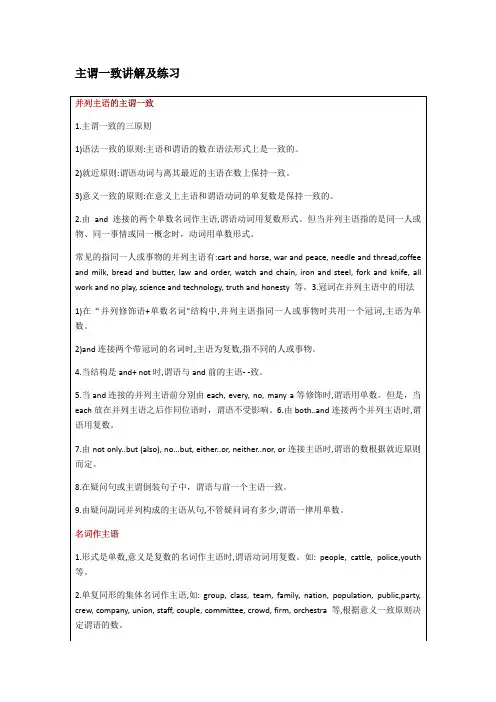
主谓一致讲解及练习3. Chinese, French, mathematics, statistics, electronics, economics, politics, linguistics,optics等表示语言或学科的单词作主语时,谓语动词用作单数。
Chinese, Japanese, French, English 表示某国人时,根据意义一致的原则决定谓语的数。
4. works (工厂),means (方法) series (系列), deer( 鹿), sheep(绵羊)根据所暗示的数来决定谓语的数。
5.以-s结尾的表示由成对部分组成的物体的名词作主语时,谓语动词用复数。
如trousers,glasses, scissors, pants等。
如果这些词与a pair of, a couple of连用,动词的数与pair,couple的数保持-致。
6. clothes, goods, wages, stairs, taxes, earnings, belongings, savings, leavings 作复数用,其后面的谓语动词要用复数。
7. news, music, equipment, luggage, information, furniture, advice, progress等不可数名词作主语时,谓语动词用单数。
1.表示国家城市、机构、组织的专有名词一般视为单数,作主语时谓语动词用单数。
2.某些表示群岛、山脉、瀑布的专有名词往往作复数用,作主语时谓语动词用复数。
3.以复数形式出现的表示书籍、报纸、杂志的专有名词一般视为单数,作主语时谓语动词用单数。
4.以复数形式出现的表示同姓的一家人或同名、同姓的若干人的名词作主语,谓语动词用复数。
1.主语之后带有as well as, as much as, rather than, more than, no less than等短语时,谓语动词的数与前面的主语保持一致。
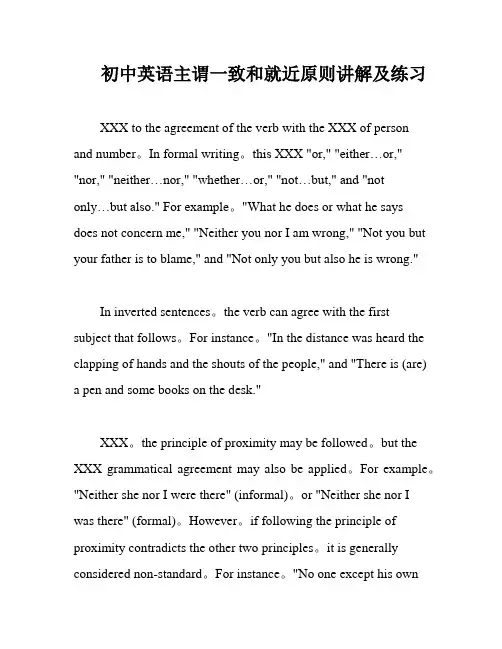
初中英语主谓一致和就近原则讲解及练习XXX to the agreement of the verb with the XXX of personand number。
In formal writing。
this XXX "or," "either…or," "nor," "neither…nor," "whether…or," "not…but," and "not only…but also." For example。
"What he does or what he says does not concern me," "Neither you nor I am wrong," "Not you but your father is to blame," and "Not only you but also he is wrong."In inverted sentences。
the verb can agree with the first subject that follows。
For instance。
"In the distance was heard the clapping of hands and the shouts of the people," and "There is (are) a pen and some books on the desk."XXX。
the principle of proximity may be followed。
but the XXX grammatical agreement may also be applied。
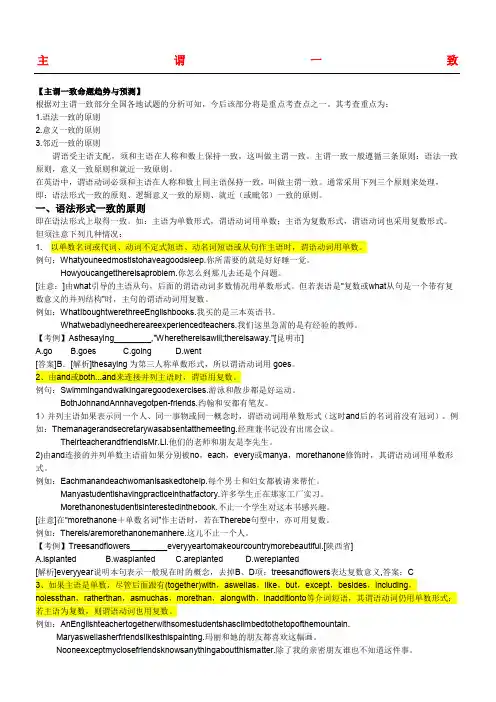
主谓一致【主谓一致命题趋势与预测】根据对主谓一致部分全国各地试题的分析可知,今后该部分将是重点考查点之一。
其考查重点为:1.语法一致的原则2.意义一致的原则3.邻近一致的原则谓语受主语支配,须和主语在人称和数上保持一致,这叫做主谓一致。
主谓一致一般遵循三条原则:语法一致原则,意义一致原则和就近一致原则。
在英语中,谓语动词必须和主语在人称和数上同主语保持一致,叫做主谓一致。
通常采用下列三个原则来处理,即:语法形式一致的原则、逻辑意义一致的原则、就近(或毗邻)一致的原则。
一、语法形式一致的原则即在语法形式上取得一致。
如:主语为单数形式,谓语动词用单数;主语为复数形式,谓语动词也采用复数形式。
但须注意下列几种情况:1. 以单数名词或代词、动词不定式短语、动名词短语或从句作主语时,谓语动词用单数。
例句:Whatyouneedmostistohaveagoodsleep.你所需要的就是好好睡一觉。
Howyoucangetthereisaproblem.你怎么到那儿去还是个问题。
[注意:]由what引导的主语从句,后面的谓语动词多数情况用单数形式。
但若表语是“复数或what从句是一个带有复数意义的并列结构”时,主句的谓语动词用复数。
例如:WhatIboughtwerethreeEnglishbooks.我买的是三本英语书。
Whatwebadlyneedhereareexperiencedteachers.我们这里急需的是有经验的教师。
【考例】Asthesaying________,"Wherethereisawill;thereisaway."[昆明市]A.goB.goesC.goingD.went[答案]B.[解析]thesaying为第三人称单数形式,所以谓语动词用goes。
2、由and或both...and来连接并列主语时,谓语用复数。
例句:Swimmingandwalkingaregoodexercises.游泳和散步都是好运动。
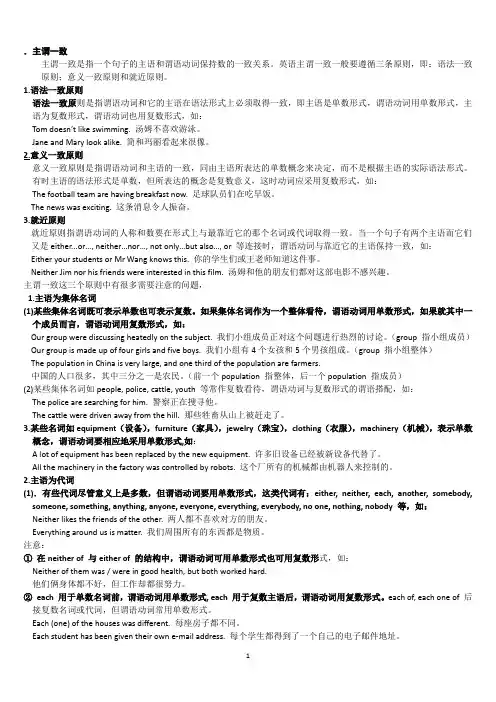
.主谓一致主谓一致是指一个句子的主语和谓语动词保持数的一致关系。
英语主谓一致一般要遵循三条原则,即:语法一致原则;意义一致原则和就近原则。
1.语法一致原则语法一致原则是指谓语动词和它的主语在语法形式上必须取得一致,即主语是单数形式,谓语动词用单数形式,主语为复数形式,谓语动词也用复数形式,如:Tom doesn’t like swimming. 汤姆不喜欢游泳。
Jane and Mary look alike. 简和玛丽看起来很像。
2.意义一致原则意义一致原则是指谓语动词和主语的一致,同由主语所表达的单数概念来决定,而不是根据主语的实际语法形式。
有时主语的语法形式是单数,但所表达的概念是复数意义,这时动词应采用复数形式,如:The football team are having breakfast now. 足球队员们在吃早饭。
The news was exciting. 这条消息令人振奋。
3.就近原则就近原则指谓语动词的人称和数要在形式上与最靠近它的那个名词或代词取得一致。
当一个句子有两个主语而它们又是either...or…, neither…nor…, not only…but also…, or 等连接时,谓语动词与靠近它的主语保持一致,如:Either your students or Mr Wang knows this. 你的学生们或王老师知道这件事。
Neither Jim nor his friends were interested in this film. 汤姆和他的朋友们都对这部电影不感兴趣。
主谓一致这三个原则中有很多需要注意的问题,1.主语为集体名词(1)某些集体名词既可表示单数也可表示复数。
如果集体名词作为一个整体看待,谓语动词用单数形式,如果就其中一个成员而言,谓语动词用复数形式,如:Our group were discussing heatedly on the subject. 我们小组成员正对这个问题进行热烈的讨论。

初中英语主谓一致和就近原则讲解及练习Prepared on 21 November 2021英语语法——主谓一致(就近、就远原则)就近原则:也称“邻近原则”“就近一致原则”(Proximity),即:谓语与靠近的名词、代词(有时不一定是主语)在“人称、数”上一致。
在正式文体中:1.由下列词语连接的并列主语:"there be+句型; or ; either …or;nor; neither…nor;whether…or;not…but; not only…but also" ; 等。
e.g.①What he does or what he says does not concern me . 他的行为或言谈都与我无关。
②Neither you nor I am wrong . 你和我都没错。
③Not you but your father is to blame . 不是你,而是你父亲该受责备。
④Not only you but(also) he is wrong .不仅你错了,他也错了。
2. 在倒装句中:谓语可与后面第一个主语一致。
e.g.①In the distance was heard the clapping of hands and the shouts of the people . 在远处,能听见鼓掌声和人们的呼喊声。
②There is (are) a pen and some books on the desk .桌上有一支钢笔和几本书。
II. 非正式文体中:有时依“就近一致原则”,但也可依“意义一致原则”或严格地依“语法一致原则”。
e.g.Neither she nor I were there (意义一致) 我和他当时都不在那儿。
(非正式)Neither she nor I was there .(就近一致)(译文同上句)(正式)但是,如果依“就近一致原则”而与其他两项原则相矛盾时,则常常认为是不太合符规范的。
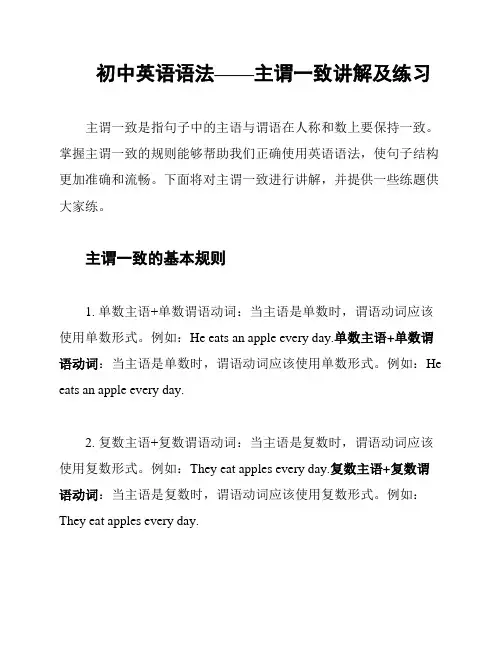
初中英语语法——主谓一致讲解及练习主谓一致是指句子中的主语与谓语在人称和数上要保持一致。
掌握主谓一致的规则能够帮助我们正确使用英语语法,使句子结构更加准确和流畅。
下面将对主谓一致进行讲解,并提供一些练题供大家练。
主谓一致的基本规则1. 单数主语+单数谓语动词:当主语是单数时,谓语动词应该使用单数形式。
例如:He eats an apple every day.单数主语+单数谓语动词:当主语是单数时,谓语动词应该使用单数形式。
例如:He eats an apple every day.2. 复数主语+复数谓语动词:当主语是复数时,谓语动词应该使用复数形式。
例如:They eat apples every day.复数主语+复数谓语动词:当主语是复数时,谓语动词应该使用复数形式。
例如:They eat apples every day.3. 不以-s, -es, -ies结尾的复数主语,还原为单数形式+单数谓语动词:当主语是不以-s, -es, -ies结尾的复数名词时,谓语动词应使用单数形式。
例如:My family is going on a trip this weekend.不以-s, -es, -ies结尾的复数主语,还原为单数形式+单数谓语动词:当主语是不以-s, -es, -ies结尾的复数名词时,谓语动词应使用单数形式。
例如:My family is going on a trip this weekend.4. 以-s, -es, -ies结尾的复数主语,使用复数谓语动词:当主语是以-s, -es, -ies结尾的复数名词时,谓语动词应使用复数形式。
例如:The cats play in the garden.以-s, -es, -ies结尾的复数主语,使用复数谓语动词:当主语是以-s, -es, -ies结尾的复数名词时,谓语动词应使用复数形式。
例如:The cats play in the garden.5. 连接词and连接的两个主语,使用复数谓语动词:当两个主语被连接词and连在一起时,谓语动词应使用复数形式。
主谓一致英语句子中,主语的“人称”和“数”要限制、决定谓语动词的形式变化,这就叫“主语谓语一致”关系。
它通常依据三项原则:语法一致、意义一致(即:谓语动词的形式取决于主语所表达的内在涵义)和就近一致(也称“邻近原则”,即:谓语与靠近的名词或代词在“人称、数”上一致)。
就近一致(也称“邻近原则”)语法一致意义一致(即:谓语动词的形式取决于主语所表达的内在涵义)专项练习1.More than one boy _________ to play badminton with girls in our class.A. chooseB. is choosingC. are choosingD. chooses2.— _____ you at school last night?— No, I _____ at home.A. Was; wasB. Were; wereC. Were; wasD. Was; were3.All the information except these two pieces _____ writing the article.A. have been used toB. has been used toC. have been used forD. has been used for4.— How Dave? —He is fine.A. areB. isC. amD. be5.In our school library there a number of books on science and the number ofthem growing larger and larger.A. is , areB. are , isC. has , isD. have , are6.— This pair of shoes __________ really small for me.— Why not try another _________.A. is, pairB. are, pairC. is, oneD. are, one7.Are ________ Kate's ________?A. this, bookB. that, bookC. these, booksD. those, book8.The ______ about the sports meeting make us excited.A. newsB. informationC. messagesD. advice9.Peter and I _________ in Room 807.A. amB. isC. areD. /10.The price of these pants _____ very high.A. areB. isC. haveD. has11.Gina _______my cousin. We _______good friends.A. is, areB. are, areC. are, isD. is, is12.There a panda and two lions in yesterday's film.A. wereB. wasC. had13.There ________ 60 students in my class.A. amB. isC. areD. have14.Some children were in the classroom and the rest _________ in the playground.A. wasB. wereC. areD. is15.There _________ a basketball match between Class Two and Class Four this afternoon.A. is going to beB. will haveC. is going to have16._______ right after meals is bad for our health.A. RunB. RunningC. Runs17.Neither of the two students _______ the teacher who is much too strict.A. likeB. likesC. likingD. liked18.I have two children. Each of them _______ his own room.A. haveB. hasC. havingD. to have19.________Rita ________ her mother know my address. They often visit me at my home.A. Not; butB. Not only; but alsoC. Both; andD. Either; or20.The number of students in our school _________ more than 2000.A. isB. areC. has beenD. was21.The Blacks __________ in the park last Sunday.A. isB. areC. wasD. were22.— Many people think Wei Fang ______ her mother.— Me, too.A. be likeB. look likeC. is likeD. like23.— How much _______ the trousers?— _______ 88 yuan.A. is; ItB. are; TheyC. is; It’sD. are; They’re24.A large number of Hollywood movies in China every year. The number of imported (进口) Hollywood movies in 2014 34.A. are shown; isB. are shown; areC. is shown; isD. is shown; are25.Dropping litter ______ never allowed in our city.A. don'tB. areC. willD. is26.My brother ______ a soccer ball and I _____one.A. have, hasB. has, haveC. have, haveD. has, has27.— We ordered beef noodles, but _______ any beef in the noddles.— Put on your glasses and you can see the beef.A. there isB. there isn'tC. there aren't28. my friends.A. This areB. These areC. These isD. This is29.—Do you like your new T-shirt?—Yes. Not only I but also my mother __________ it.A. doesn't likeB. likeC. likesD. don't like30.There _________ some sheep and a horse in the picture.A. areB. isC. has31.— Hello, what _______ your name?— I _______ Sally Brown.A. is; isB. is; amC. are; isD. am; are32.Either you or your father _______ TV in the evening.A. watchB. watchesC. don't watchD. watchs33.-- ________ there any sheep on the hill?-- ________.A. Is; Yes, there areB. Are; Yes, there areC. Is; No, there isn’tD. Are; No, there isn’t参考答案:DCDBB ACCCB ABCBA BBBCA DCDAD BBBCA BBB二、填空题35.The number of the students ________ (be) fifty in our class.36.A large bowl of noodles ________ (be) on the table.37.The number of the students in our school ________ (be) over 2, 500.参考答案:is is is。
初中英语主谓一致的用法及专项练习题一、主谓一致三原则主谓一致是指谓语动词与主语在人称和数上保持一致,主谓一致一定按照三原则:语法一致原则 ,意义一致原则 ,就近一致原则。
1.语法一致原则 :指主语是单数形式 ,谓语动词用单数形式 ,主语是复数形式 ,谓语也用复数形式。
Tom is a good student.汤姆是个勤学生。
They often play football on the playground. 他们常常在操场上踢足球。
2.意义一致 :指主语形式上为单数 ,但意义为复数 ,所以谓语动词用复数形式 ;或主语形式上为复数 ,但表示单数意义 ,这是谓语动词用单数形式。
My family is having lunch now. 我们一家人此刻正吃午餐。
My family has moved three times.我们家搬过 3 次。
3.就近一致 :指谓语动词用单数形式仍是用复数形式 ,取决于最凑近他的主语。
比如 :Not only the teacher but also his students like playing football.不单老师喜爱踢足球 ,并且他的学生也喜爱踢足球。
There is a pen and some books on the desk课.桌上有一支钢笔和一些书。
二、主谓一致常考题型1.单数名词 (代词 ,不行数名词作主语时 ,谓语用单数形式 ,复数名词 (代词作主语 , 谓语用复数形式。
The desk is Tom’张这s.桌子是汤姆的。
Some water is in the bottle.一些水在瓶子里。
The students are playing football on the playground.这些学生正在操场上踢足球。
2.many a+单数名词作主语 ,意义虽为“很多”,但谓语要用单数形式。
Many a student has been to Shanghai许.多学生到过上海。
初中英语主谓一致的用法与专项训练题一、主谓一致三原则主谓一致是指谓语动词与主语在人称和数上保持一致,主谓一致必须遵循三原则:语法一致原则,意义一致原则,就近一致原则。
1.语法一致原则:指主语是单数形式,谓语动词用单数形式,主语是复数形式,谓语也用复数形式。
Tom is a good student. 汤姆是个好学生。
They often play football on the playground. 他们经常在操场上踢足球。
2.意义一致:指主语形式上为单数,但意义为复数,因此谓语动词用复数形式;或主语形式上为复数,但表示单数意义,这是谓语动词用单数形式。
My family are having lunch now.我们一家人现在正吃午饭。
Twenty dollars is too expensive for the book.这本书20美元太贵了。
3.就近一致:指谓语动词用单数形式还是用复数形式,取决于最靠近他的主语。
例如:Not only the teacher but also his students like playing football。
不仅老师喜欢踢足球,而且他的学生也喜欢踢足球。
There is a pen and some books on the desk.课桌上有一支钢笔和一些书。
二、主谓一致常考题型1. 单数名词(代词,不可数名词作主语时,谓语用单数形式,复数名词(代词作主语,谓语用复数形式。
The desk is Tom’s. 这张桌子是汤姆的。
Some water is in the bottle. 一些水在瓶子里。
The students are playing football on the playground. 这些学生正在操场上踢足球。
2. many a+单数名词作主语,意义虽为“许多”,但谓语要用单数形式。
Many a student has been to Shanghai. 许多学生到过上海。
英语语法——主谓一致(就近、就远原则)就近原则:也称“ 近原”“就近一致原” (Proximity),即:与靠近的名、代(有不一定是主)在“人称、数”上一致。
在正式文体中:1. 由下列接的并列主:"there be +句型 ; or ; either;⋯norr; neither⋯nor;whether ⋯ or;not ⋯ but; not only⋯but also"等;。
e.g.①What he does or what he says does not concern me .他的行或言都与我无关。
②N either you nor I am wrong . 你和我都没。
③N ot you but your father is to blame . 不是你,而是你父受。
④Not only you but(also) he is wrong . 不你了,他也了。
2. 在倒装句中:可与后面第一个主一致。
e.g.①In the distance was heard the clapping of hands and the shouts of the people .在,能听鼓掌声和人的呼喊声。
②T here is (are) a pen and some books on the desk . 桌上有一支笔和几本。
II.非正式文体中:有依“就近一致原”,但也可依“意一致原”或格地依“ 法一致原”。
e.g.Neither she nor I were there (意一致)我和他当都不在那儿。
(非正式)Neither she nor I was there .(就近一致)(文同上句)(正式)但是,如果依“就近一致原”而与其他两原相矛盾,常常是不太合符范的。
e.g.No one except his own supporters agree with him .他自己的支持者同意他的意。
(依“就近”和“意”一致的原;但法上,“ No one ”才是主,要改成“agrees ”。
“写作中”一般要依“ 法一致”原。
英语就近原则短语1.There be 句型There is a book and some pencils on the desk.=There are some pencils and a book on the desk.2.neither...nor...Neither you nor he is right. = Neither he nor you are right.3.either...or...Either they or Jim is going to Shanghai next Saturday.= Either Jim or they are going to shanghai next Saturday.4.not only...but also... Not only Ann but also her parents stay at home every Sunday.= Not only Ann's parents but also she stays at home every Sunday.就远原则谓语动词与前面主语一致代表词汇:as well as ;(together/along )with ;rather than ;except ;besides ;but ;including ; in addition to ;apart from例子: He rather than I is right.Nobody but two students is in the classroom.主谓一致单项填空专练主谓一致是历年中考热点之一,一般说来 ,句子的主语和谓语在人称与数上应保持一致,但在很多情况下存在一些特殊情况,这些特殊情况就是重要考点。
本文以往年高考试题为例,对此考点作以归纳。
一、当主语后面与with, as well as, but, except, like, rather than, no less than,besides, including等+名词或代词连用时,谓语动词与第一个主语保持一致。
1.The teacher, with 6 girls and 8 boys of her class, ________ visiting amuseum when the earthquake struck.A. wasB. wereC. had beenD. would be2.A library with five thousand books ________ to the nation as a gift.A. is offeredB. has offeredC. are offeredD. have offered3.E-mail, as well as telephones, ________ an important part indaily communication.A. is playingB. have playedC. are playingD. play4.Nobody but Jane ________ the secret.A. knowB. knowsC. have knownD. is known5. All but one ________ here just now.A. isB. wasC. has beenD. were二、当either ... or ...; neither ... nor...;not only... but also...等连接并列主语时,谓语动词与靠近它的主语保持一致。
6.Either you or the headmaster ________ the prizes to these gifted students atthe meeting.A. was handing outB. are to hand outC. are handing outD. is to hand out7.Not only I but also Jane and Mary ________ tired of having oneexamination after another.A. isB. areC. amD. be三、当“ the only one of +复数名词+ 定语从句” ,且关系代词在定语从句中作主语时,定语从句的谓语动词用单数形式;当“ one of +复数名词+定语从句” ,且关系代词在定语从句中作主语时 ,定语从句的谓语动词用复数形式。
8. He is the only one of the students who ________ a winner of scholarship forthree years.A. isB. areC. have beenD. has been9.She is one of the few girls who ________ in the kindergarten. A.is well paid B. are well paid C. is paying well D. are paying well四、当 news, means, maths, plastics, physics等在形式上是复数概念,而在意义上是单数概念的名词作主语时 ,谓语动词用单数形式。
10.Every possible means ________ to prevent the pollution, but the sky is still not clear.A. is usedB. are usedC. has been usedD. have been used五、当分数 (百分数 )+of+ 名词作主语时 ,谓语动词的数取决于of 后面名词的数。
11. ________ of the land in that district ________ covered with trees and grass.A. Two fifth; isB. Two fifth; areC. Two fifths; isD. Two fifths; are六、 the number of...(⋯⋯的数目)短作主,用数形式;当a numberof...( 多⋯⋯)短作主 ,用复数形式。
12.The number of people invited ________fifty, but a number of them ________ absent for different reasons.A. were; wasB. was; wasC. was; wereD. were; were七、当“疑+不定式” 构作主,常用数形式。
13. When and where to build the new factory ________ yet.A. is not decidedB. are not decidedC. has not decidedD. have not decided以上从七个方面了主一致的特殊情况,但在学中不止些,希望同学在以后的学中此多加留意,以不断丰富、充其内容,未来高考做好准。
参考答案 : 1 — 5 AAABD 6 — 10 DBDBC 11 — 13 CCA。